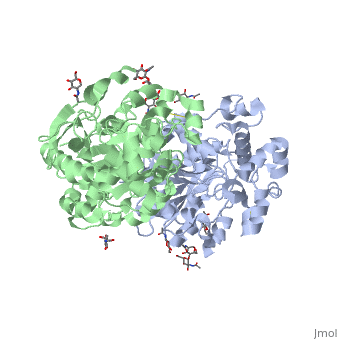From Proteopedia
proteopedia linkproteopedia link
Introduction
Human gastric lipase (HGL, E.C. 3.1.1.3) (PBD ID: 1hlg) is a type of lipase (of the enzyme class hydrolase) that is responsible for initiating the digestion of dietary fats in the stomach [1]. This enzyme is secreted by the fundic chief cells of the human stomach and catalyzes 10-20% of total lipolytic processes (i.e., those involving fat breakdown) in healthy adults [1]. HGL specifically catalyzes the hydrolysis of triacylglycerol in order to produce diacylglycerol and a carboxylate byproduct [2], a process that facilitates subsequent fat breakdown by pancreatic lipase [3]. In terms of disease implications, there is evidence to suggest that HGL secretion is altered in individuals with gastritis [4].
Structural highlights
HGL, a 379 amino acid residue-long lipase enzyme, possesses a catalytic arm consisting of residues Ser-153, His-353, and Asp-324 [2].
Function
Relevance to Human Health & Disease
A study was completed to discover the understanding of hormonal regulation of gastric lipase secretion in children and adolescents, as this is still very limited.
The activity of human gastric lipase was compared among two experimental groups and one control group. The control group included 14 healthy adolescents. The experimental groups were one group of 10 patients diagnosed with Helicobacter pylori gastritis, and another group of patients exposed to other pathogens besides Helicobacter pylori to cause gastritis. The activity of human gastric lipase was observed through endoscopic measurements within the collected gastric juice from each patient. The plasma concentrations of glucagon-like peptide-1, cholecystokinin, and glucose-dependent insulinotropic peptide were determined in all patients as well.
This study suggested that the activity of human gastric lipase activity was changed in patients that were diagnosed with superficial gastritis induced by pathogens other than Helicobacter pylori. The level of activity of human gastric lipase was significantly lower in patients with superficial gastritis than in patients that were healthy (p<0.005) and were diagnosed with Helicobacter pylori gastritis (p<0.005). The mean levels of glucose-dependent insulinotropic peptide plasma concentrations were lower for patients in the control group (p<0.005) than in non-Helicobacter pylori gastritis and Helicobacter pylori gastritis patients (p<0.01). The regulation of human gastric lipase secretion by glucagon-like peptide-1 and cholecystokinin was found to be altered in those whom had gastritis. Glucose-dependent insulinotropic peptide in both healthy and gastritis-diagnosed patients was found to be a powerful controller of human gastric lipase activity [4].
References
- ↑ 1.0 1.1 Armand M, Hamosh M, DiPalma JS, Gallagher J, Benjamin SB, Philpott JR, Lairon D, Hamosh P. Dietary fat modulates gastric lipase activity in healthy humans. Am J Clin Nutr. 1995 Jul;62(1):74-80. PMID:7598069
- ↑ 2.0 2.1 Roussel A, Canaan S, Egloff MP, Riviere M, Dupuis L, Verger R, Cambillau C. Crystal structure of human gastric lipase and model of lysosomal acid lipase, two lipolytic enzymes of medical interest. J Biol Chem. 1999 Jun 11;274(24):16995-7002. PMID:10358049
- ↑ Selvan A, Seniya C, Chandrasekaran SN, Siddharth N, Anishetty S, Pennathur G. Molecular dynamics simulations of human and dog gastric lipases: insights into domain movements. FEBS Lett. 2010 Nov 19;584(22):4599-605. doi: 10.1016/j.febslet.2010.10.021. Epub, 2010 Oct 20. PMID:20965171 doi:http://dx.doi.org/10.1016/j.febslet.2010.10.021
- ↑ 4.0 4.1 Tomasik PJ, Wedrychowicz A, Rogatko I, Zajac A, Fyderek K, Sztefko K. Gastric lipase secretion in children with gastritis. Nutrients. 2013 Jul 29;5(8):2924-32. doi: 10.3390/nu5082924. PMID:23899880 doi:http://dx.doi.org/10.3390/nu5082924

